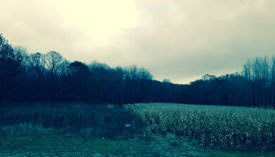Upper Peninsula - Western Mackinac County
 Over
1,300 oak saplings were planted in western Mackinac County this spring
to increase hard mast for deer. The plantings were focused on areas
that have been hit hard by beech bark disease (BBD),
and also in deer wintering complexes. BBD areas will see a large loss
of beech nuts, and the oak acorns that are produced in the future will
help to mitigate some of the loss from BBD. “We were able to get
saplings planted to help avoid problems with deer browse, and as a bonus
they’ll also throw acorns sooner,” said DNR wildlife biologist Dave
Jentoft. “We had great cooperation with our sister division, the Forest
Resources Division, in making these plantings happen.”
Over
1,300 oak saplings were planted in western Mackinac County this spring
to increase hard mast for deer. The plantings were focused on areas
that have been hit hard by beech bark disease (BBD),
and also in deer wintering complexes. BBD areas will see a large loss
of beech nuts, and the oak acorns that are produced in the future will
help to mitigate some of the loss from BBD. “We were able to get
saplings planted to help avoid problems with deer browse, and as a bonus
they’ll also throw acorns sooner,” said DNR wildlife biologist Dave
Jentoft. “We had great cooperation with our sister division, the Forest
Resources Division, in making these plantings happen.”Northern Lower Peninsula - Kalkaska County
 The
Fletcher area in southern Kalkaska County is a great destination this
fall for deer hunters. Over 1,600 acres of public land is available to
set up camp during firearm, late archery or even muzzleloader season.
This spring over 470 acres were prescribed-burned in an effort to kill
woody plants that are closing in on this large grassland complex. Over
120 acres were mowed, and numerous acres were planted to winter wheat,
rape and turnips. Visit Mi-HUNT to explore this area from home, and make plans to visit in person to hunt the fall and early winter seasons.
The
Fletcher area in southern Kalkaska County is a great destination this
fall for deer hunters. Over 1,600 acres of public land is available to
set up camp during firearm, late archery or even muzzleloader season.
This spring over 470 acres were prescribed-burned in an effort to kill
woody plants that are closing in on this large grassland complex. Over
120 acres were mowed, and numerous acres were planted to winter wheat,
rape and turnips. Visit Mi-HUNT to explore this area from home, and make plans to visit in person to hunt the fall and early winter seasons.Southwest Lower Peninsula - Cass County
 Over the past year, staff members at the Crane Pond State Game Area
have installed over 200 acres of food plots and other plantings for the
benefit of wildlife on the game area. Food plots are placed in
strategic locations to enhance recreational opportunities. The picture
to the left shows a field border adjacent to a corn food plot. Such
practices allow species such as deer, turkey and pheasants to have
transitional and security cover adjacent to important high-calorie
winter food sources. Field borders also provide valuable nesting and
bedding cover and can greatly enhance the number of bird species using
an area. This is just one example of the many habitat management
practices implemented at the game area over this past year.
Over the past year, staff members at the Crane Pond State Game Area
have installed over 200 acres of food plots and other plantings for the
benefit of wildlife on the game area. Food plots are placed in
strategic locations to enhance recreational opportunities. The picture
to the left shows a field border adjacent to a corn food plot. Such
practices allow species such as deer, turkey and pheasants to have
transitional and security cover adjacent to important high-calorie
winter food sources. Field borders also provide valuable nesting and
bedding cover and can greatly enhance the number of bird species using
an area. This is just one example of the many habitat management
practices implemented at the game area over this past year.Southeast Lower Peninsula - St. Clair County
Funds from the license restructuring are helping the DNR Wildlife Division make habitat improvements for deer and other wildlife around the state. Port Huron State Game Area is no exception. With an increased budget for habitat work, more seasonal wildlife assistants were hired this year, allowing 9 additional acres at Port Huron SGA to be converted to food plots of corn and small grains. This brings the total acreage planted with food plots to 20. These employees also worked on improving parking lots and posting additional signage around the area to improve hunter accessibility. Check out Port Huron State Game Area for an enhanced hunting experience this fall.
Explore the public lands near you, and have a safe and memorable hunt!















